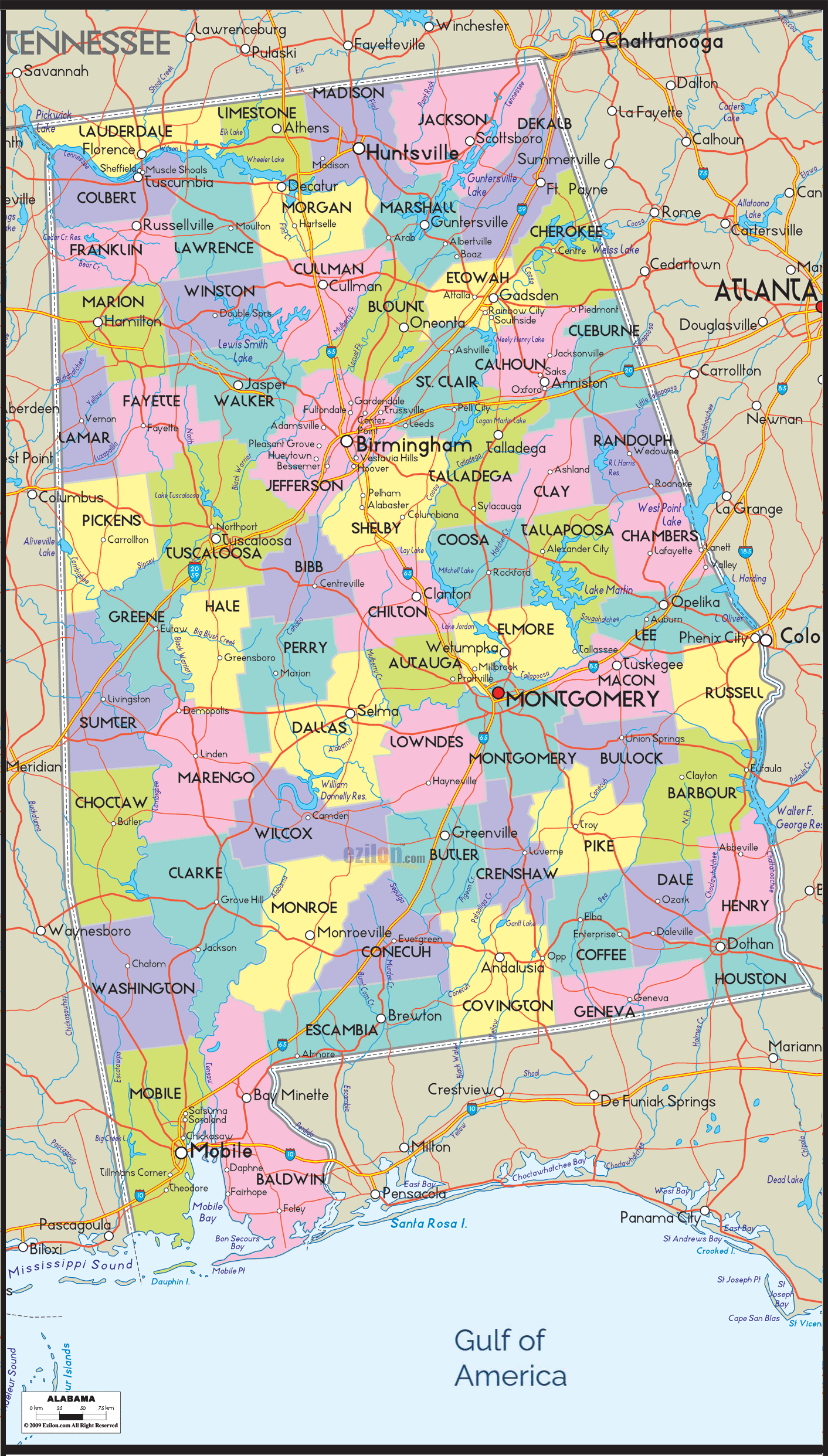

Description: Detailed large map of Alabama State USA showing cities, towns, county formations, roads, US highways and State routes.

As you unroll or zoom into this large, detailed map of Alabama cities, counties and roads, you're greeted by more than mere geographical formations. Indeed, this isn't just a map; it's a multi-layered story, almost like a visual novel of Alabama's essence. Through this cartographic tapestry, you'll traverse the state's dynamic cities, charming small towns, and counties with unique road outlines, each exquisitely marked with its own set of colors, lines, and symbols. The map serves as a guidebook to Alabama's complex political landscapes, historical landmarks, and cultural attractions, emphasizing natural resources, historical sites, and modern amenities.
When you gaze toward the North, the energetic city of Huntsville immediately catches your eye. You'll see it in a big white circle. It's linked to nearby Athens and Decatur by the bold Line representing I-565. The Line wiggles further westward, morphing into US-72, leading to the Shoals region. The roadways here aren't mere lines; they are the narrative threads that tie these northern gems together, almost like branches of a family tree rooted deeply in Alabama's soil.
Trailing down, you can't overlook the web of roads surrounding Birmingham, prominently marked by a large white circle. I-20 connects Birmingham to Anniston to the east, a highway depicted as a bold line, not just a route but a lifeline that feeds cultural and economic energy into these cities. It's a veritable artery of commerce, history, and life.
As you continue traveling south, you will see the cities of Mobile and Dothan. A US-231, a significant highway, joins them with its curved route. This road isn't just a travel route; think of it as a ribbon tying the maritime culture of Mobile to the agricultural richness of Dothan. It is a southern corridor that's as crucial to Alabama's identity as the stars are to the night sky.
Looking west, you can spot Tuscaloosa and Selma, linked by AL-21 and AL-5, almost as if by a historic thread. Each town is a white dot or circle on the map, yet these simple shapes have profound historical and cultural implications. These roads aren't just asphalt but paved with stories of intellectual triumphs and civil rights milestones.
Returning to the center, Montgomery is like the beating heart of Alabama, denoted by a particularly eye-catching white circle. Around it is a complex network of roads like I-65, I-85, and US-231, resembling veins and arteries emanating from a vital organ. They stretch out their asphalt arms to cities like Prattville, Wetumpka, and Millbrook, all depicted as white dots or circles, forming a celestial constellation in the heart of Alabama.
The map also faithfully represents Alabama's state boundaries, with thick lines denoting the borders with Mississippi to the west, Georgia to the east, Florida to the south, and Tennessee to the North. These aren't just lines; they're conversations between Alabama and its neighboring states. Notice how, with its white circle, Phenix City sits tantalizingly close to the Georgia border, connected by I-20 that seamlessly transits into I-59, narrating a tale of cross-border camaraderie.
In addition to its pinpoint representation of urban hubs, the map intricately distinguishes other routes and boundaries. Highways like AL-13 in the northwest, AL-87 in the south, and US-11 stretching from Birmingham to the Tennessee border are not just footnotes. They're akin to the captions under the photos in a family album—they provide context, history, and a deeper connection to the land.
So, here it is—a map that is not just a visual display but a harmonious composition of Alabama's geographical, historical, and cultural diversities. From the sci-tech marvels in the North to the rich maritime legacies in the south, and from the vibrant intellectual hubs in the west to the history-soaked soils in the east, this map is your guidebook, your encyclopedia, your storytelling grandma all rolled into one. Roads like I-65, I-85, I-20, US-231, and countless more aren't mere roads; they are the state's lifelines, plotted carefully like musical notes on a grand orchestral score.
Origin of State Name: The name Alabama originates from a Native American language, thought to mean "tribal town." Aptly named, the state serves as a communal hub of various cultural, historical, and social narratives, which you can vividly experience through this intricately detailed map.
Location & Geography: Alabama, in the southeast of the United States, is commonly known as the "Heart of Dixie." The state is adjacent to Tennessee, Georgia, Florida, the Gulf of Mexico, and Mississippi. Known for its diverse landscapes, Alabama features mountains in the North, flatlands and coastal plains in the south, and rich river valleys in between.
The state capital is Montgomery, a city rich in history and the birthplace of the American Civil Rights Movement. Birmingham, the largest city, is an industrial and cultural hub. Other significant towns include Mobile, Huntsville, and Tuscaloosa, each with unique contributions to Alabama's economic and cultural landscape.
Economy: Alabama's economy is multifaceted, encompassing industries like manufacturing, aerospace, healthcare, and agriculture. The state is a significant producer of poultry, cattle, and soybeans. Automotive manufacturing is another vital sector, with companies like Mercedes-Benz, Honda, and Hyundai operating large plants.
History & Culture: Alabama is steeped in American history, playing pivotal roles in the Civil War and the Civil Rights Movement. Cultural landmarks like the Rosa Parks Museum in Montgomery, the Civil Rights Institute in Birmingham, and the ancient Native American city of Moundville provide deep insights into the state's complex past.
Tourism: Tourists flock to Alabama for its Gulf Coast beaches, such as Gulf Shores and Orange Beach. In addition, the state offers numerous opportunities for outdoor recreation, such as hiking in the southern region of the Appalachian Mountains, discovering caves in the northern mountainous areas, and engaging in various water sports in numerous lakes and rivers.
Sports: Alabamians have a deep passion for college football, with the rivalry between the University of Alabama and Auburn University being one of the most followed in American sports.
The state bird is the Yellowhammer.
The state flower is the Camellia.
The state tree is the Longleaf Pine.
The state is famous for its Southern hospitality, food, and country music.
Conclusion: Alabama is a state of contrasts, with a mix of history, culture, and modern industry that is as diverse as its landscapes. From its civil rights landmarks to its booming aerospace sector, the state embodies the evolving narrative of the American South.
1. Gulf Shores and Orange Beach: These places by the coast have magnificent beaches in Alabama. They offer a great setting to unwind under the sun, swim, and participate in water-based recreational pursuits. With powdery white sand and crystal-clear waters, it's a paradise for beach lovers.
2. Birmingham Civil Rights Institute: This informative museum provides a compelling look into the struggles and triumphs of the Civil Rights Movement, offering a profoundly moving experience that is both educational and eye-opening.
3. U.S. Space & Rocket Center, Huntsville: A must-see for science and space enthusiasts, this center offers an extensive collection of rockets, exhibits on the U.S. space program, and interactive science displays. It's the home of the famed Space Camp for kids.
4. Cheaha State Park: This state park is home to Alabama's highest point, Cheaha Mountain, offering breathtaking panoramic views. It's an ideal spot for outdoor adventures with hiking trails, waterfalls, and camping options.
5. Auburn vs. Alabama Football Game: The Iron Bowl, the annual football game between the University of Alabama and Auburn University, is not just a sports event but a cultural phenomenon. The rivalry is intense, and the atmosphere is electric.
6. Montgomery's Civil Rights Landmarks: The Rosa Parks and the Dexter Avenue King Memorial Baptist Church are places that honor essential figures in history. One of these figures is Martin Luther King Jr. He was a pastor, and these landmarks are essential places that show the history of the Civil Rights Movement.
7. Mobile Bay: Known for its historic battles and natural beauty, it is perfect for boating, fishing, and exploring historic sites like Fort Morgan and the USS Alabama Battleship Memorial Park.
8. Little River Canyon National Preserve: People often identify this place as the "Grand Canyon of the East ."It has beautiful views, waterfalls, and chances to go kayaking, rock climbing, and hiking.
9. Birmingham Zoo: One of the oldest zoological parks in the U.S., it houses over 800 animals and provides various interactive exhibits, making it a fun day out for families.
10. Barber Vintage Motorsports Museum, Birmingham: A haven for motorcycle enthusiasts, this museum has one of the world's most extensive collections of vintage and contemporary motorcycles.
11. Moundville Archaeological Park: This ancient Native American site offers an insight into the prehistoric Mississippian culture, featuring mounds once part of a bustling city.
12. Ruffner Mountain Nature Preserve: Located close to downtown Birmingham, this urban nature preserve offers various trails for hiking and bird-watching, making it a perfect escape within the city.
Alabama is more than just a Southern state; it's a tapestry of history, culture, and natural wonders. Alabama has something for everyone, whether you're into sports or the great outdoors.

Physical Map of Alabama
Physical map and map image of Alabama.

Road Map of Alabama
Road map and map image of Alabama.

Regional Directory of United States of America
Information and guide about United States of America and websites with American topics.

Regional Directory of Europe
Information and guide about Europe and websites with European topics.

Regional Directory of Australia
Information and guide about Australia and websites with Australian topics.